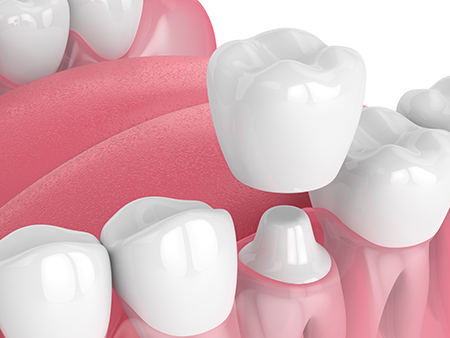Now Accepting Medicaid At All Locations!
Now Accepting Medicaid At All Locations!

At the office of New Day Dentistry, we combine modern technology with thoughtful restorative care to protect teeth that have suffered decay, injury, or wear. Our goal is to restore function while preserving as much natural tooth structure as possible, and ceramic crowns are one of the most versatile tools available to accomplish that.
Advances in ceramic materials have changed the way dentists approach full-coverage restorations. Today’s all-ceramic crowns provide strength, lifelike aesthetics, and excellent biocompatibility — making them an attractive choice for many restorative and cosmetic situations. Below, you’ll find a clear overview of when crowns are recommended, how ceramic options differ, and what you can expect from treatment.
A crown becomes a practical option when a tooth can’t be restored reliably with a filling alone. Large cavities, fractures that compromise chewing surfaces, or teeth that have lost substantial structure after root canal therapy often need the full coverage and reinforcement that a crown provides. Unlike direct restorations, crowns encase the entire visible portion of the tooth to restore strength and protect it from further damage.
Dental crowns are also commonly used to top dental implants, to anchor bridges, or to reshape a tooth that is worn, misshapen, or discolored beyond what veneers can address. The goal is always to recreate both the appearance and the mechanical function of the original tooth so you can chew comfortably and smile confidently.
Deciding whether a crown is necessary involves more than looking at an X-ray. Our team evaluates the tooth’s remaining structure, bite forces, occlusion (how your teeth come together), and aesthetic goals. We discuss the pros and cons of restoring the tooth conservatively versus using a crown so you can make an informed choice that balances durability and appearance.
To repair and rebuild a tooth with extensive structural damage due to decay or trauma
To replace a large or broken dental filling
To restore a dental implant
To provide full coverage for the abutment teeth that support a dental bridge
To strengthen and protect a tooth that has undergone root canal therapy
To improve the look of an undersized, slightly misaligned, darkly stained, or misshapen tooth
To address bite discrepancies

One of the main advantages of modern ceramic crowns is their ability to mimic the way natural teeth interact with light. High-quality ceramics have translucency and surface texture that replicate tooth enamel, producing a seamless appearance that blends with adjacent teeth. For front teeth where appearance matters most, ceramic crowns offer a subtle, life-like result.
Beyond aesthetics, all-ceramic restorations are designed with biocompatibility in mind. Because they are metal-free, they eliminate concerns about metal sensitivity and avoid the dark margins that can sometimes appear with metal-based crowns at the gumline. The result is a restoration that is both gentle on soft tissue and consistently attractive over time.
Durability has improved dramatically with contemporary ceramics. Materials such as lithium disilicate and high-strength zirconia provide excellent fracture resistance suitable for many clinical situations. When selected and placed correctly, ceramic crowns can withstand everyday chewing forces while maintaining their color and surface finish.
Here are key reasons dentists often recommend all-ceramic crowns:
They closely mimic the translucency and sheen of natural teeth for superior esthetics
They often require less removal of healthy tooth structure compared with older crown designs
They are lighter in weight and free of metal, reducing the chance of tissue irritation or sensitivity
They resist staining and maintain a stable appearance when properly cared for
They eliminate visible metal margins that can become noticeable at the gumline over time

Not all ceramic crowns are the same; materials vary in strength, translucency, and the way they are fabricated. The best choice depends on the tooth’s location, how much chewing force it will receive, and your cosmetic goals. Front teeth often demand greater translucency and color matching, while back teeth need materials that can withstand higher biting forces.
Modern dental ceramics include a range of options from pressed glass-ceramics to layered or monolithic zirconia. Each has distinct strengths: some prioritize esthetics and lifelike translucency, while others emphasize structural robustness. Our clinicians consider these trade-offs when recommending a material tailored to your mouth.
We take a conservative, evidence-based approach to material selection. That means we balance the long-term functional demands with the desire for a natural look, selecting a ceramic that will perform well in your specific situation and integrate with the rest of your smile.
Lithium Disilicate Porcelain Crowns
Leucite Reinforced Pressable Porcelain Crowns
Solid or Monolithic Zirconia
High Translucent Zirconia

The process of receiving a ceramic crown typically unfolds over two or more visits. During the first appointment, the tooth is assessed, any decay is removed, and the tooth is shaped to create a stable foundation. Digital impressions or traditional molds are taken so the lab or milling unit can produce a crown that matches your bite and neighboring teeth.
While your permanent restoration is being fabricated, a temporary crown protects the prepared tooth and helps maintain normal function. On your return visit, the temporary is removed and the permanent crown is fitted, adjusted, and bonded into place. We verify the fit, make bite adjustments as needed, and polish the surface to blend seamlessly with surrounding teeth.
Aftercare is straightforward: maintaining good oral hygiene, avoiding excessively hard or sticky foods on the restored tooth immediately after placement, and keeping regular dental checkups will help your crown last. With proper care, the restoration can provide reliable service for many years.
We focus on thorough planning and clear communication so patients understand each step of treatment. That includes discussing the reasons a crown is recommended, the material options available, and how a crown will affect the appearance and function of the tooth. Our clinicians work to align technical excellence with your personal goals for your smile.
Technology plays a role in precision and efficiency. We use digital imaging and planning tools when appropriate to design restorations that fit accurately and look natural. Whether a crown is milled in-office or crafted by a trusted dental laboratory, quality control and attention to detail guide every decision.
Our team also emphasizes long-term maintenance. Routine hygiene visits and timely follow-up catch potential issues early so your restoration continues to perform as intended. If you have questions about materials, treatment timing, or how a crown will integrate with other dental work, we take the time to explain options in clear, practical terms.
In summary, ceramic crowns offer a modern solution for restoring teeth that require strength, protection, and a natural appearance. They are a versatile option for addressing structural damage, finishing implant work, supporting bridges, and improving the look of a compromised tooth.
If you’d like to learn more about how ceramic crowns might fit into your treatment plan, please contact us for more information. Our team is happy to discuss your needs and help you understand the pathway to a healthy, resilient smile.
A ceramic crown is a full-coverage dental restoration made from advanced, tooth-colored ceramic materials that replace the visible portion of a damaged tooth. Unlike metal or porcelain-fused-to-metal crowns, all-ceramic crowns contain no metal substructure and are designed to mimic the translucency and surface texture of natural enamel. These restorations are manufactured using materials such as lithium disilicate or zirconia, which vary in translucency and strength depending on clinical needs.
Ceramic crowns offer improved aesthetics and biocompatibility compared with older metal-based options, and they eliminate the risk of dark margins at the gumline that can appear with metal-backed designs. Material selection is driven by the tooth's location, bite forces, and the desired cosmetic outcome. When chosen and placed appropriately, ceramic crowns provide both functional support and an appearance that blends with surrounding teeth.
A ceramic crown is typically recommended when a tooth has lost substantial structure due to decay, fracture, or root canal therapy and cannot be reliably restored with a filling alone. Crowns fully encase the visible portion of the tooth, providing reinforcement and protection against further damage in situations where partial restorations would be insufficient. Crowns are also indicated when a tooth serves as an abutment for a bridge or must restore a dental implant.
The decision to use a crown versus a veneer or filling depends on remaining tooth structure, the extent of cosmetic concerns, and functional demands such as bite forces. Veneers are conservative and suited for surface-level cosmetic changes, while crowns address structural weakness as well as appearance. Your clinician will evaluate structural integrity, occlusion, and aesthetic goals to recommend the most appropriate restoration.
Clinicians consider material properties such as strength, translucency, and wear characteristics when selecting a ceramic for a crown. For front teeth where aesthetics are paramount, more translucent materials like lithium disilicate or high-translucency ceramics may be preferred to achieve lifelike color and light transmission. For molars and areas that endure heavy chewing forces, stronger options such as monolithic zirconia are often chosen for their fracture resistance.
The choice also accounts for the amount of tooth reduction required, the need to match adjacent teeth, and whether the crown will be layered or monolithic. A conservative, evidence-based approach balances long-term function with cosmetic expectations. Your dental team will explain trade-offs so you understand why a specific material is recommended for your mouth.
The ceramic crown process commonly unfolds over two or more visits beginning with an assessment, removal of decay if present, and shaping of the tooth to create a stable foundation. Digital or conventional impressions are then taken to record the prepared tooth and occlusion, enabling fabrication of a well-fitting restoration by a lab or an in-office milling unit. A temporary crown protects the tooth and maintains function while the permanent crown is made.
At the follow-up visit, the temporary is removed and the permanent crown is tried in, adjusted for fit and bite, and bonded or cemented into place using dental adhesives. The clinician verifies occlusion and makes any final polishing or contouring adjustments to ensure comfort and aesthetics. Post-procedure instructions focus on care during the initial healing period and routine oral hygiene to support longevity.
Care for a ceramic crown centers on good oral hygiene practices, including twice-daily brushing with a nonabrasive toothpaste and daily flossing to protect the supporting tooth and surrounding gum tissue. Avoiding very hard or sticky foods immediately after placement helps prevent dislodgement or damage to the new restoration while adhesives fully set. Routine dental checkups and professional cleanings allow the team to monitor the crown and the health of the underlying tooth and gums.
If you notice changes such as persistent sensitivity, a loosened crown, or unusual bite awareness, contact your dental office for evaluation so small issues can be addressed before they progress. Using a night guard may be recommended for patients who clench or grind their teeth to reduce undue stress on crowns. With attentive care and regular dental visits, ceramic crowns can provide reliable function and appearance over many years.
All-ceramic crowns are generally considered biocompatible and well tolerated by soft tissues because they contain no metal and exhibit low rates of allergic reaction. The absence of metal eliminates the potential for metal sensitivity in susceptible patients and reduces the chance of dark gumline discoloration that can occur with metal-based restorations. Ceramic materials are also stable and resist staining when maintained with appropriate oral hygiene.
As with any dental restoration, proper diagnosis, material selection, and precise fit are important to prevent complications such as marginal leakage or fracture. Your clinician evaluates medical history, periodontal health, and occlusal factors to ensure a ceramic crown is a safe choice for your situation. If concerns about material compatibility arise, the dental team can discuss alternative restorative options.
Yes, ceramic crowns can be used on both anterior and posterior teeth, but the preferred material may differ depending on location and functional demands. For front teeth, materials with higher translucency and superior color-matching capabilities are favored to achieve natural aesthetics. For back teeth that require greater fracture resistance, denser ceramics such as monolithic zirconia are often selected to withstand chewing forces.
The treatment plan customizes the restoration type to meet both cosmetic and mechanical requirements of the specific tooth. Clinicians also consider opposing dentition and parafunctional habits when planning crowns in the posterior region. Proper material selection and accurate fabrication help ensure that crowns perform well in any part of the mouth.
Common risks associated with crown treatment include sensitivity after preparation, marginal gaps if fit is imperfect, and the potential for crown fracture under extreme force. Proper tooth preparation, accurate impressions or digital scans, and careful cementation reduce these risks and improve the long-term success of the restoration. Clinicians routinely check occlusion and make adjustments to minimize abnormal forces that could compromise the crown.
Should complications such as loosening, persistent pain, or visible margin issues arise, the practice will evaluate the restoration and underlying tooth to determine corrective steps, which may include re-cementation, modification, or replacement of the crown. Timely follow-up and routine dental exams help detect early signs of problems so they can be addressed conservatively whenever possible.
Alternatives to ceramic crowns include large direct restorations (such as composite or amalgam fillings), onlays or partial crowns, veneers for primarily cosmetic improvements, and extraction followed by implant-supported restorations in cases where the tooth cannot be saved. Onlays and partial coverage restorations can preserve more natural tooth structure when the damage is not extensive, whereas full crowns are indicated when comprehensive coverage is necessary. Veneers are limited to cosmetic surface changes and are not suitable for restoring significant structural loss.
The choice among these options depends on the tooth's remaining structure, occlusal forces, aesthetic goals, and long-term prognosis. Your dental team will outline feasible alternatives and explain the benefits and limitations of each so you can choose a restorative path that aligns with your oral health needs. Evidence-based planning helps ensure the selected option supports both function and appearance.
The practice emphasizes thorough planning, accurate diagnostics, and clear communication to deliver predictable ceramic crown outcomes. This includes assessing the tooth and surrounding tissues, using digital imaging and precision impressions when appropriate, and selecting materials that balance strength with esthetics for the specific clinical situation. Attention to fit, occlusion, and proper bonding technique further supports long-term performance of the restoration.
New Day Dentistry combines modern technology with an evidence-based approach to restorative care and coordinates follow-up and maintenance recommendations tailored to each patient. By explaining treatment steps and material choices in practical terms, the team helps patients understand how crowns will restore both function and appearance. Regular recall visits and timely management of concerns contribute to durable, reliable results.